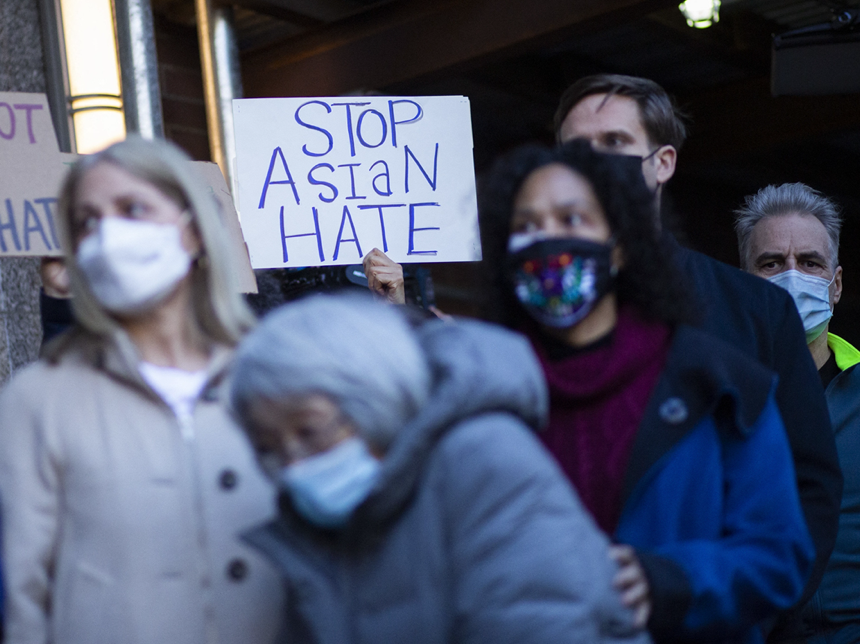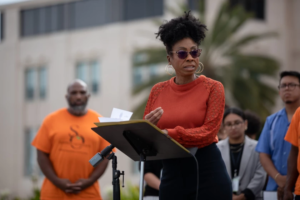What should you do if you witness harassment, or worse, an assault?
That question came into sharp focus this week following an attack on a 65-year old Filipino immigrant outside an apartment building in Midtown Manhattan.
Caught on surveillance video, the assault is disturbing to watch, but what appears to have happened inside the building is also prompting an outcry. The video shows a man in the lobby glancing up at what’s happening outside. He watches as the perpetrator stomps on the victim repeatedly. He appears to do nothing in response. A few moments later, another man inside the lobby approaches the glass door and shuts it.
“We don’t know the full story from the bystanders who were present,” says Dax Valdes, a senior trainer with the group Hollaback! “But I think the heartbreaking thing for me was seeing the door close.”
Valdes has been leading trainings offered by Hollaback! along with Asian Americans Advancing Justice/AAJC this past year. The idea is to give bystanders tools for intervening when they see someone being harassed or disrespected, with a focus on the person experiencing the conflict.
“We have been operating in this environment where the Asian-American community has been experiencing heightened anxiety and fear over the last– more than the last year,” says Marita Etcubañez, senior director of strategic initiatives at Asian Americans Advancing Justice/AAJC. “We recognized that there was a need for training, education, but also tactics that people could readily put to use.”
Through free webinar trainings, Valdes and Etcubañez lay out a number of tactics, which they call the Five Ds. They shared some of those tactics with NPR’s Ari Shapiro during an interview on All Things Considered.
Distract
Creating a distraction is one way to de-escalate a situation, Hollaback! says.
“You could maybe walk by the people who are experiencing the conflict, and you could pretend to be clumsy and drop a bottle of water or drop a cup of coffee. Everybody’s going to back up because they don’t want to get wet,” says Valdes. “Or you could pretend you know the person who’s experiencing the conflict, walk up to them, [say] ‘Oh, my goodness. I’m so sorry I’m late.’ You’re just creating that safe space around them.”
Delegate
In short, get help from someone else.
“Maybe it is somebody who presents as physically bigger, who could step in and intervene on your behalf,” says Valdes.
“If you’re on public transit, it could be the bus driver, or transit security,” says Etcubañez. “Enlist others to help out. As you’re considering intervening, you wouldn’t be alone.”
Document
Filming a conflict can be useful, especially if you can include street signs or other landmarks and note the date and time, but Hollaback! recommends only doing so from a safe distance and not posting any video footage online without the permission of the targeted person.
Delay
Etcubañez calls this the lowest stakes form of intervention.
“This is where you would approach the person after the conflict has passed and check in to make sure they’re okay,” she says. “If they need help, get them help. Offer to sit with them.”
Direct
Before directly intervening, Valdes says establish your own safety first.
“If the situation does escalate into physical violence, or medical attention is needed, then yes, we recommend that people call the proper authorities to help deal with that situation,” he says.
Sofia Dupi lives outside New York City and attended a session early in the pandemic. She says it helped her understand some of the emotional pain Asians and Asian Americans were already experiencing last spring.
“During the training, people were sharing how they’ve been harassed, spit on in public,” she says. The session gave her a sense that there is almost always something that she as a bystander could do in such a scenario, even if it’s just checking in.
“It allows you to help the person being harassed regain that sense of humanness,” Dupi says. “It really looks out for their emotional well-being, which I think is so vital.”
Demand for training has been enormous. Hollaback! and Asian Americans Advancing Justice/AAJC say they’ve trained over 20,000 people through March 2021, and since the mass shootings in metro Atlanta, more than 45,000 people have signed up.
“We have been frankly overwhelmed by the response, especially in recent weeks as we have been adding new training dates,” says Etcubañez. “To me, it really signifies that people are eager to learn what they can do and to feel empowered so that they could act should they need to.”
The initiative has garnered support from the likes of Sherrilyn Ifill, president of the NAACP Legal Defense and Educational Fund, who took to Twitter to praise the “real strategies” the training offers, and from Chelsea Clinton, who tweeted about the rise in anti-Asian hate crimes and the responsibility people have to reverse the trend and protect lives.
Valdes points out that the tools they’re sharing are not limited to this moment and can be used in any kind of situation where someone is experiencing harassment or disrespect.
“As the vaccinations roll out, and the mask mandates perhaps roll back, as we go out into the real world, we’re going to have to learn how to readjust to each other in public space,” he says. “These are going to be good strategies to have in our back pockets.”




